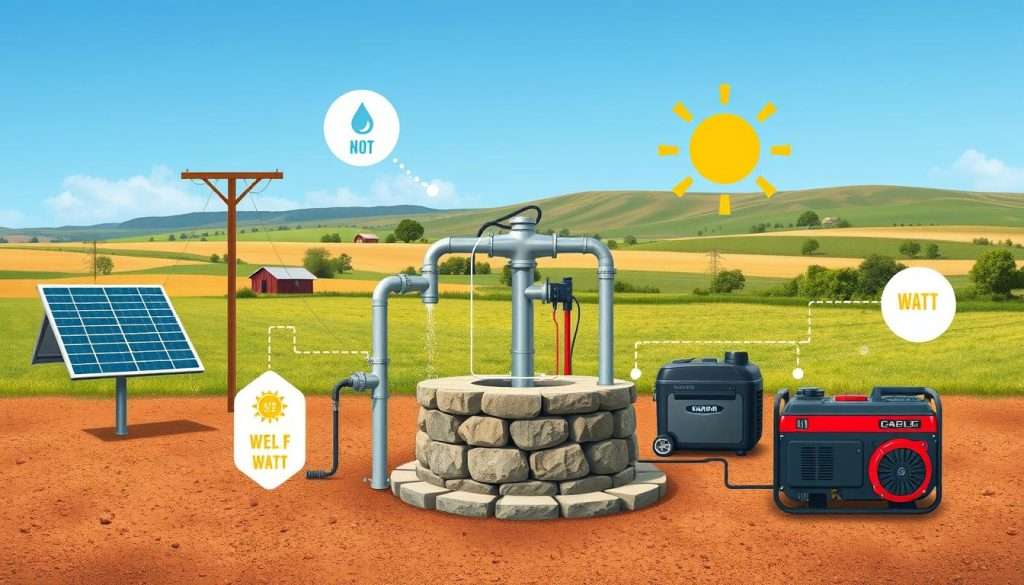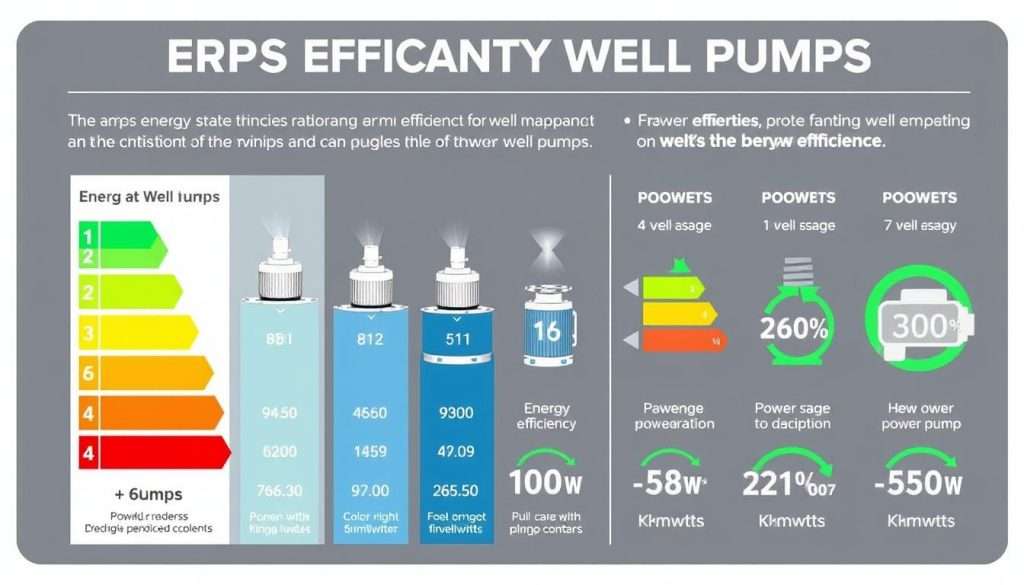Knowing how many watts a well pump uses is key for a reliable water supply. It helps choose energy sources like solar panels or backup generators. Pumps use 500 to 5,000 watts, based on type, well depth, and water flow.
A typical well pump for a home uses 500 to 2,500 watts. For example, a shallow pump might use 1,500 watts. A deeper pump could need up to 2,500 watts. The motor’s efficiency also matters, as better motors use less power.
In this guide, we’ll explore well pump electricity usage and how to calculate your needs. Knowing these details helps pick the best pump and energy source for your home.
Key Takeaways
- Well pump wattage can vary from 500 to 5,000 watts based on type and usage.
- A typical household well pump operates at 700 to 800 watts on average.
- Motor efficiency impacts energy consumption for well pumps.
- Depth of the well and flow rate determine the necessary horsepower.
- Solar generators can efficiently power well pumps, reducing fuel costs.
Understanding Well Pump Basics
Knowing about well pump basics is key for homeowners with private water. This device pulls water from underground and brings it to homes or gardens. Learning about well pumps helps you pick the right one for your needs.
What is a Well Pump?
A well pump brings water from a well to the surface. They come in different sizes and work for shallow or deep wells. Knowing how a well pump works helps you choose the best one for your water needs.
Types of Well Pumps
There are many types of well pumps for different uses. Knowing these types helps you take better care of your pump:
- Submersible Pumps: These pumps are below the water level, great for deep wells.
- Jet Pumps: Good for shallow wells, they create a vacuum to pull water up.
- Centrifugal Pumps: These pumps move water fast, perfect for high flow rates.
- Hand Pumps: Manual pumps are good for emergencies or low water needs.
How Well Pumps Work
Well pumps work by creating pressure to move water up. They run on electricity or gasoline. It’s important to know your pump’s specs, like horsepower and amp draw, for energy use.
Smaller pumps use less power. A 15 amp circuit is often used for pumps under 0.5 hp. These pumps draw about 5 amps or 700 watts when working.
| Circuit Breaker Size | Pump Size | Amperage | Watts During Operation | Generator Size Needed |
|---|---|---|---|---|
| 15 amp | Smaller than 0.5 hp | ~5 amps | ~700 watts | 1.2 KW |
| 20 amp | Smaller than 0.75 hp | ~8 amps | ~1100 watts | 2 KW |
| 25 amp | 1 HP or smaller | ~9 amps | ~1400 watts | 2.5 KW |
| 30 amp | Smaller than 2 hp | ~13 amps | ~2300 watts | 4 KW |
| 40 amp | Smaller than 3 hp | ~16 amps | ~3200 watts | 5 KW |
| 50 amp | Smaller than 5 hp | ~25 amps | ~5300 watts | 7.5 KW |
With this info, you can choose the right well pump for your needs. This ensures your pump works well and efficiently.
Power Requirements for Well Pumps
Knowing how much power well pumps need is key for homeowners. Many things affect how much power a well pump uses. This can change your energy bills a lot. By understanding these points, you can make better choices about your energy use and budget.
Factors Affecting Power Consumption
There are several things that change how much power a well pump uses:
- Motor Size: The size of the motor, measured in horsepower (HP), affects how much power it uses. Smaller pumps might use 750 watts, while bigger ones can use up to 5,000 watts.
- Operating Time: How long a pump runs also matters. For example, a pump that runs 8 hours a day might use between 6.4 to 9.6 kilowatt-hours of energy.
- Efficiency: How well a pump works is also important. A drop in efficiency of about 15% should be considered when figuring out how much power it really uses.
- Type of Energy Source: Using solar power for well pumps is becoming more popular. It can save money and reduce the need for fossil fuels.
Common Wattage Ranges for Different Types
Wattage for pumps varies based on their size and use. Here’s a quick guide:
| Pump Type | Motor Size (HP) | Starting Wattage (watts) | Running Wattage (watts) |
|---|---|---|---|
| Small Residential Pump | 0.33 HP | 1,500 | 750 |
| Standard Pump | 1.0 HP | 2,000 | 1,000 |
| Medium Pump | 1.5 HP | 2,500 | 1,500 |
| Large Commercial Pump | 5.0 HP | 5,000 | 16,000 |
Choosing the right pump means knowing these wattage ranges. This helps make sure your power supply meets your pump’s needs. It also helps with figuring out costs and improving energy use.

Calculating Energy Usage
It’s key to know how to figure out energy use for your well pump. This helps you see how much electricity it uses. It’s good for planning your budget and knowing the cost of KWH.
Estimating Daily Wattage Consumption
Well pumps use different amounts of power. Small ones use 700 to 800 watts. Big ones use 2000 to 5000 watts. To find out daily use, multiply the watts by the hours it runs.
- 1500 watts x 8 hours = 12,000 watt-hours (or 12 kWh).
This shows how much your pump uses in a day. It’s important for knowing how much power it uses.
Using KWH for Cost Analysis
After finding out your pump’s daily use, figure out the cost. Electric companies charge by the kilowatt-hour. To find the cost, multiply the daily use by the rate. For example, if your pump uses 6.4 kWh a day and the rate is $0.12, the monthly cost is:
- Daily usage: 6.4 kWh
- Monthly usage: 6.4 kWh x 30 days = 192 kWh
- Cost: 192 kWh x $0.12 = $23.04.
This way, you can easily see how much your pump costs. It helps you make smart choices about energy use and saving money.
Energy Efficiency Ratings
Choosing a well pump means looking at energy efficiency ratings. These ratings show how well a pump uses electricity. Pumps that use less energy cost less to run and are better for the planet.
Understanding Energy Efficiency
Well pump energy efficiency is about how much energy a pump uses. Different pumps use different amounts of energy. Knowing this helps pick the right pump for your needs.
Importance of Selecting Efficient Pumps
Choosing efficient pumps saves money and energy. They use less power, which means lower bills. For example, a pump running 8 hours a day uses about 6.4 kilowatt-hours. This shows how much you can save with efficient pumps.

| Pump Size (HP) | Starting Watts | Running Watts | Efficiency Rating |
|---|---|---|---|
| 0.33 HP | 1,500 – 2,400 | 750 – 800 | High |
| 0.5 HP | 1,500 – 2,500 | 800 – 1,200 | Medium |
| 1 HP | 2,000 – 3,200 | 1,200 – 1,500 | High |
| 1.5 HP | 2,500 – 3,500 | 1,500 – 2,500 | Medium |
By focusing on energy efficiency, you can find the right pump. This choice is good for your wallet and the planet.
Tips for Reducing Well Pump Energy Usage
Lowering your well pump’s energy use can save a lot of money. It also keeps your water supply steady and reliable. By using smart tips and regular checks, you can make your pump more efficient and cut down on energy costs.
Optimizing Pump Schedule
Creating a good pumping schedule is key to saving energy. Run your pump when electricity is cheaper or when there’s less demand. Here are some tips:
- Make the pump run at night when electricity is cheaper.
- Do all your water tasks at once to cut down on pump use.
- Use smart irrigation controllers that adjust based on weather and soil.
With a smart schedule, your pump will only work when it needs to.
Regular Maintenance Practices
Don’t forget to keep your pump and system in top shape. Regular care means your pump works better, using less energy. Here’s what to do:
- Check the pump for wear and fix it fast.
- Clean filters and remove debris to keep things running smoothly.
- Find and fix leaks to avoid extra pumping.
- Update old systems with newer, energy-saving pumps.
By doing these things, you’ll make your pump more efficient and use less power. For more tips, check out this blog post. Keeping your well system in good shape will help save energy and keep it working well for a long time.
Choosing the Right Well Pump for Your Needs
When picking a well pump, knowing your water needs is key. You must think about the well’s depth, how much water you want, and any extra pressure needs. Deeper wells need pumps with more power because they have to lift water higher.
A 200-foot well might only need a ½ HP pump for low flow. But, if you need more water, you might need a 1.5 HP pump.
Assessing Your Water Needs
How much water you need depends on your property’s size and how you use it. Homes need different amounts of water, from a few gallons to hundreds. It’s important to know exactly what you need.
Tools like pump curves help match your needs with the right pump. This ensures you get the best fit for your home.
Finding the Right Pump Size and Power Level
Don’t think bigger is always better when it comes to horsepower. Look for the right size and power for your situation. Think about the total lift, including any extra pressure from tanks, to avoid wasting money.
A good pump can save you money in the long run. It uses less energy, saving you money now and later.
